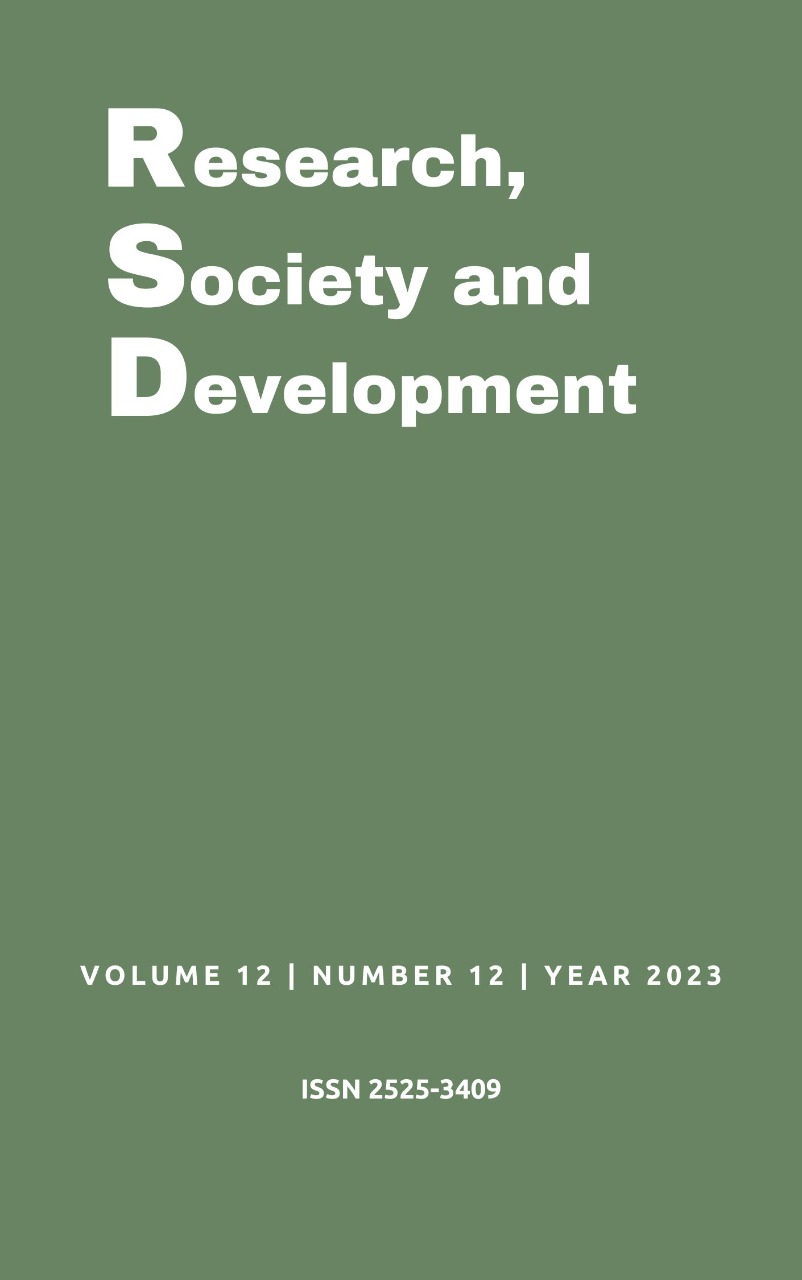Oral manifestations in patients with eating disorders
DOI:
https://doi.org/10.33448/rsd-v12i12.44029Keywords:
Anorexia nervosa, Nervous bulimia, Oral manifestations.Abstract
Eating disorders (ED) correspond to a group of psychopathological disorders that affect individuals' relationship with food and their body. Bringing as a consequence harmful habits that result in emotional and functional instability and, in extreme cases, death. The dentist has an essential role in the secondary prevention of these disorders, considering that the oral cavity of these patients presents characteristic signs. However, despite the seriousness of the issue, due to the lack of training that allows reaching a diagnostic hypothesis, a significant portion of professionals are unsure about the measures to be taken. This may indirectly contribute to the worsening of the clinical condition. This work is an integrative review with the aim of evaluating the manifestations present in the oral cavity resulting from eating disorders, anorexia nervosa and bulimia nervosa, as well as bringing a perspective of the dental surgeon as a health professional about their importance in these cases.
References
Cordás, T. A. (2004). Transtornos alimentares: classificação e diagnóstico. Archives of Clinical Psychiatry, 31(4), 154–157. https://doi.org/10.1590/s0101-60832004000400003
DeBate, R. D., Shuman, D., & Tedesco, L. A. (2007). Eating disorders in the oral health curriculum. Journal of Dental Education, 71(5), 655–663. https://pubmed.ncbi.nlm.nih.gov/17493974/
Debate, R. D., & Tedesco, L. A. (2006). Increasing dentists’ capacity for secondary prevention of eating disorders: identification of training, network, and professional contingencies. Journal of Dental Education, 70(10), 1066–1075. https://pubmed.ncbi.nlm.nih.gov/17021286/
DeBate, R. D., Tedesco, L. A., & Kerschbaum, W. E. (2005). Knowledge of oral and physical manifestations of anorexia and bulimia nervosa among dentists and dental hygienists. Journal of Dental Education, 69(3), 346–354. https://pubmed.ncbi.nlm.nih.gov/15749945/
DeBate, R. D., Vogel, E., Tedesco, L. A., & Neff, J. R. (2006). Sex differences among dentists regarding eating disorders and secondary prevention practices. 137(6), 773–781. https://doi.org/10.14219/jada.archive.2006.0289
Ela, F. para. (2021, July 1). Transtornos Alimentares afetam cerca de 10 milhões de pessoas no Brasil. Feito Para Ela. https://feitoparaela.com.br/2021/07/01/transtornos-alimentares-afetam-cerca-de-10-milhoes-de-pessoas-no-brasil/
Figueiredo, B. Q. de. (2022). Eating disorders: etiologies, triggering factors, management challenges, and screening methods. https://oasisbr.ibict.br/vufind/Record/UNIFEI_f3b584e11cb912b3af4aa6721a3840d9
Fleitlich, B. W., Larino, M. A., Cobelo, A., & Córdas, T. A. (2000). Anorexia nervosa na adolescência. J. Pediatr., S323–S329. https://pesquisa.bvsalud.org/bvsms/resource/pt/lil-279212
Hasan, S., Ahmed, S., Panigrahi, R., Chaudhary, P., Vyas, V., & Saeed, S. (2020). Oral cavity and eating disorders: An insight to holistic health. Journal of Family Medicine and Primary Care, 9(8), 3890–3897. https://doi.org/10.4103/jfmpc.jfmpc_608_20
Langlois Oliveira, L., & Simon Hutz, C. (2010). Transtornos alimentares: o papel dos aspectos culturais no mundo contemporâneo eating disorders: the role of cultural aspects in the contemporary world. https://www.scielo.br/j/pe/a/MGVrVGGrjn8VPDYyCqdmNLj/?format=pdf
Lourenço, M., Azevedo, Á., Brandão, I., & Gomes, P. S. (2017). Orofacial manifestations in outpatients with anorexia nervosa and bulimia nervosa focusing on the vomiting behavior. Clinical Oral Investigations, 22(5), 1915–1922. https://doi.org/10.1007/s00784-017-2284-y
Lozano-Muñoz, N., Borrallo-Riego, Á., & Guerra-Martín, M. D. (2022). Influencia de las redes sociales sobre la anorexia y la bulimia en las adolescentes: una revisión sistemática. Anales Del Sistema Sanitario de Navarra, 45(2), e1009–e1009. https://doi.org/10.23938/ASSN.1009
Mais de 70 milhões de pessoas no mundo possuem algum distúrbio alimentar. Ministério Da Saúde. https://www.gov.br/saude/pt-br/assuntos/noticias/2022/setembro/mais-de-70-milhoes-de-pessoas-no-mundo-possuem-algum-disturbio-alimentar
Monda, M., Costacurta, M., Maffei, L., & Docimo, R. (2021). Oral manifestations of eating disorders in adolescent patients. A review. European Journal of Paediatric Dentistry, 22(2), 155–158. https://doi.org/10.23804/ejpd.2021.22.02.13
Panico, R., Piemonte, E., Lazos, J., Gilligan, G., Zampini, A., & Lanfranchi, H. (2018). Oral mucosal lesions in Anorexia Nervosa, Bulimia Nervosa and EDNOS. Journal of Psychiatric Research, 96, 178–182. https://doi.org/10.1016/j.jpsychires.2017.09.022
Pinzon, V., & Nogueira, F. C. (2004). Epidemiologia, curso e evolução dos transtornos alimentares. Archives of Clinical Psychiatry, 31(4), 158–160. https://doi.org/10.1590/s0101-60832004000400004
Romanos, G. E., Javed, F., Romanos, E. B., & Williams, R. C. (2012). Oro-facial manifestations in patients with eating disorders. Appetite, 59(2), 499–504. https://doi.org/10.1016/j.appet.2012.06.016
Strumìa, R., Varotti, E., Manzato, E., & Gualandi, M. (2001). Skin Signs in Anorexia nervosa. Dermatology, 203(4), 314–317. https://doi.org/10.1159/000051779
Thaiana, P. (2022). O que é Transtorno Alimentar? Saiba como identificar e tratar. Psitto. https://www.psitto.com.br/blog/transtorno-alimentar-como-identificar/
Tirico, P. P., Stefano, S. C., & Blay, S. L. (2010). Qualidade de vida e transtornos alimentares: uma revisão sistemática. Cadernos de Saúde Pública, 26(3), 431–449. https://doi.org/10.1590/s0102-311x2010000300002
Downloads
Published
Issue
Section
License
Copyright (c) 2023 José Romário Silva dos Santos; Maria Thayná Araújo de Almeida; Raíssa Soares dos Anjos

This work is licensed under a Creative Commons Attribution 4.0 International License.
Authors who publish with this journal agree to the following terms:
1) Authors retain copyright and grant the journal right of first publication with the work simultaneously licensed under a Creative Commons Attribution License that allows others to share the work with an acknowledgement of the work's authorship and initial publication in this journal.
2) Authors are able to enter into separate, additional contractual arrangements for the non-exclusive distribution of the journal's published version of the work (e.g., post it to an institutional repository or publish it in a book), with an acknowledgement of its initial publication in this journal.
3) Authors are permitted and encouraged to post their work online (e.g., in institutional repositories or on their website) prior to and during the submission process, as it can lead to productive exchanges, as well as earlier and greater citation of published work.


